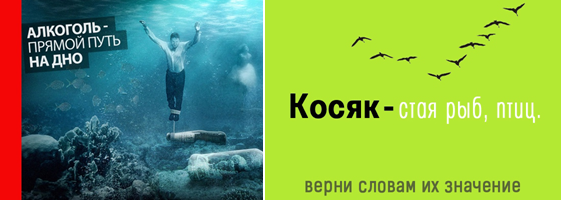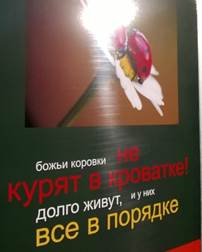Abstract
The article dwells upon the cultural and linguistic peculiarities of Russian social advertising discourse based on the study of anti-smoking, anti-drug and anti-alcohol campaigns. Social advertising is a tool used by the government and various institutions to present and promote ideas and opinions concerning social life, behaviour and lifestyle. We briefly present the history of development of Russian social advertising, which began in the twentieth century with political adverts, and focus more on the cultural, linguistic and visual components of the discourse. In advertising discourse in general, these components are inseparable and function together to create the ample vision of an advert and convey the full meaning of an idea. On the linguistic level, a surprising linguistic feature found during the research is the use of puns for serious topics. Besides this, speech strategies are described. In the cultural block, the use of cultural concepts, traditional verses and stereotypes is mentioned. We take a look at the use of typical cultural traits and how they can be connected with the general idea of an advert. The visual component is analysed according to its importance in the general message of the advert. Some adverts can exist without the visual part while in others it carries an inseparable piece of information.
Keywords: Social advertisingadvertising discoursespeech strategyRussian language,
Introduction
Social or non-commercial advertisements have long been used as a method of sharing, changing and creating important ideas, worldviews and cultural norms. They differ across the world in ways of realisation, which include forms, contents, concepts and linguistic means used to convey ideas. Social advertising discourse presents a curious field for study both from cultural and linguistic point as through studying it we can see what social problems exist in the culture and what possibilities for solving them are seen from inside the culture as well as whether any specific language constructions are are linked to certain ideas and concepts.
It should be mentioned that social advertising as a phenomenon appeared in the 20 th century in the USA and its purpose as well as initiators were mostly political. The technological advances let advertising and social advertising in particular broaden the range of possible forms, including printed, video, radio and internet advertising.
Today, social advertisements can be seen in most developed and developing countries and they mirror the social phenomena existing in the culture. By randomly choosing 100 adverts we can roughly estimate the size of a problem by looking at its percent rate within these 100.
Any social advert has two components – the verbal, linguistic side, and the extralinguistic layer, which depending on the form of the advert can include voice characteristics, font type and size, graphical images, music, sounds and much more. In quite many cases the non-linguistic part contains the whole message of the advert resulting in the absence of the verbal part.
Still, in many cultures verbal information is used to fully explain the idea, while graphical representation serves as the emotional component. Pictures in social adverts are sometimes exaggerated or photoshopped to represent the emotion at its highest.
When analysing the linguistic component, it is notable that all layers of the language can take part in creating the necessary effect. Words can be chosen according to their phonetic image to imitate certain sounds or create an aggressive effect. Words themselves can be used in their direct meaning or be part of a pun or another stylistic means. Syntax and word order play a huge role, especially when it comes to synthetic languages. Punctuation can also be used to create the necessary impression.
Problem Statement
Social advertising has existed for quite a long time, and the concepts it shares mirror the current state of the society and its existing problems.
Social advertising discourse is viewed by many as one of the subtypes of advertising discourse, which is only partly true. Advertising discourse as a type is identified by many researchers including V.I. Karasik ( 2000). While sharing the common general goal of promoting and influencing the behaviour, it differs mainly in what is being promoted and the aims of the creators. Commercial adverts aim at persuading people to think better of the products and services, which should result in buying one. Social adverts have a broader aim of making people think differently about important social issues such as family, safety, society, nature and many others. This results in different means, both linguistic and extralinguistic, used in commercial and social adverts.
Social advertising ideas may be the same across cultures, but the ways they are presented depend on the culture and the language used. It appeared at around the same time but passed through different development stages as well as it has been used for different reasons around the world.
In Russia, social advertising has developed in stages. The first stage is connected with the period of the civil war and the NEP policy in the first quarter of the twentieth century. Then came the WWII and the after-war period. During these periods social adverts were used for obvious political reasons ( Tatianchenko, 2004). The second half of the century was also about promoting healthy lifestyle, sport and culture as well as the political sphere of the USSR. Back then, the main aim was to create a positive image of the state, promote lifestyle norms and love to the country and, of course, to build up the ideology ( Shapovalov, 2012).
Modern social advertising sphere in Russia has changed from ideological line to the problems of the society. Many governmental and commercial structures use it today to promote family, traffic safety, healthy lifestyle without addictions. Still, no decent study can found that would present an ample description of this immense field of study. According to Nikolaishvili ( 2008), this field is not yet established either in Russia or anywhere else. That is why its efficiency is yet to be studied. Some aspects of it have been discussed by various Russian researches, for example, by Dykin ( 2009), Shershukova ( 2011).
Research Questions
The two main research questions are connected with the effect produced by Russian social advertising.
Linguistic and extralinguistic means used in social advertising discourse to influence people’s minds
To create a social advert it is important to understand how people can be influenced. Social adverts use both linguistic and extralinguistic means to form the opinion transferred through the advert, and the advert itself contains verbal and non-verbal components ( Gracheva, 2015). We are interested in how language can help in creating the right picture on different layers of it. At the same time, it is important to establish the connection between linguistic means and the information carried in visual part of the adverts and understand if the text works on its own.
The effect of the above mentioned means on people
The aim of any social advert is to transfer an idea and change one’s mind. However, how much is modern Russian society likely to believe and, if all, take into account, messages transferred through social advertising?
Purpose of the Study
The purpose of the study is to characterise the discourse of social advertising in the sphere of smoking, drug and alcohol abuse in Russia. We aim at describing its main features, both linguistic and extralinguistic, and showing the methods used to influence the social behaviour. The topic of adverts has been chosen due to the fact that the problem of various addictions is highly relevant in modern Russian society. According to the previous research, around 16% of all Russian social adverts use the concept of bad habits. 24% are connected with the idea of safety ( Sotnikova, 2018). In many cases, these concepts are used together. According to Stepanov ( 2007), sociological studies have shown that these concepts are among the most interesting to people together with personal safety, elections, abortions, civil rights and duties.
Research Methods
The linguocultural approach gives ground to the use of such research methods as continuous sampling for finding the research material, linguistic observation and semiotic interpretation with the inclusions of statistical analysis.
Findings
Russian social advertisements have been analysed on various layers.
Speech strategies and language use
Speech strategies are part of persuasion, which is the essence of advertising discourse ( Issers, 2008). As found previously, five speech strategies can be identified in Russian social advertising discourse. They are:
Intimidation,
Action incentive,
Dialog,
Mockery,
Result display ( Sotnikova, 2017).

Intimidation strategy, which is based on fear, is most often recognised with the concepts of
In many cases, threat is expressed through the use of scary words, statistical information and comparisons. These are some of the speech tactics that make up the strategy ( Sotnikova, 2016). As in the example on the left (Figure
Gorunovish ( 2014) states that in some case social adverts can intimidate people too much by exaggerated or excessively direct problem demonstration. This might lead to the situation where a person tries to escape any information about the problem rather than try to solve it.
Most adverts carry a direct idea and direct meaning. However, puns are used in some adverts. Even though originally intended for humorous effect, puns can give a second, more serious meaning to the words. As Figure
Some more examples of double meaning are presented below.

In the first example (Figure
One more example of a pun is presented in the next poster (fig.02, right). The slogan says, Kosyak is a group of fish or birds. Give words their meanings back. The word косяк (translit. kosyak, transl. flock, shoal) is used in slang meaning marijuana joint. Here, the meaning of the advert is fully figurative and can actually have one more meaning not connected to the bad habits idea. One more meaning of the word kosyak is fault, which is also slanging and not liked by many people.
Gorunovish ( 2014) also mentions that social advertising should not be abstract. An advert which is understood in a wrong way can lead to unwanted consequences. An advert which is not understood at all does not reach its goal.
Cultural component
Many of Russian social adverts carry distinct cultural details. One of the examples of this is the use of socially important concepts such as

In the first example (fig.
Another Russian cultural thing is traditional songs called
Not all cultural traits used in social advertising are presented positively. The well-known stereotype about heavy drinking in Russia can be exploited in social advertising to create a sad mocking effect.

Visual component and its connection to the text
The visual part of an advert is closely linked to the text and is in many ways inseparable. The picture sometimes won’t work without the slogan; the slogan will be incomprehensible without the graphical component.

As in the example above (figure
In some cases, the general idea can be fully obtained from the picture, and the text just presents certain details. Figure
As shown in figure.

The text contains a funny poem about ladybirds who do not smoke and live long. This verbal component would function the same way without the picture supporting it.
Finally, in some adverts the text and the visual part interact with each other. The above mentioned example (fig.
Conclusion
Social advertising discourse is a curious field for cultural and linguistic study. The research into Russian social advertisements on smoking, drug and alcohol abuse let us see how the language can function and what cultural aspects are used to influence people’s minds. Intimidation speech strategy is widely used in this type of advertisements, which is a logical choice when it comes to describing some unwanted, unhealthy and potentially deathly threatening concepts. The cultural layer mirrors the details typical for Russian culture – traditions and habits, both positive and negative. Finally, the study of the visual component shows that the graphical and extralinguistic parts are in many cases as important as the message transferred through text.
References
- Agrba, A. A. (2018). Social'naja reklama v Rossii i Ispanii: strukturno-komparativnyj analiz cennostnogo soderzhanija [Social advertising in Russia and Spain: structural and comparative analysis of the value content]. Konfliktologiya, 2, 54-65. Retrieved from https://nbpublish.com/library_read_article.php?id=25664
- Dykin, R. V. (2009). Jeffektivnost' social'noj reklamy: nekotorye aspekty problem [Public advertising efficiency: some aspects of the problem]. Vestnik VGU, 1, 141-149. Retrieved from http://www.vestnik.vsu.ru/pdf/phylolog/2009/01/2009-01-33.pdf
- Gorunovish, A. A. (2014). Social'naja reklama v Rossii: problemy i perspektivy [Public advertsing in Russia: problems and perspective]. Vestnik Syktyvkarskogo universiteta, 3, 69-74. Retrieved from https://www.syktsu.ru/edu/if/ign/sciense/vestnik-gumanitarnykh-nauk/%D0%92%D0%B5%D1%81%D1%82%D0%BD%D0%B8%D0%BA3(2014).pdf
- Gracheva, E. S. (2015). Osobennosti diskursa social'noj reklamy [Peculiarities of social advertising discourse]. Aktual’niye problem lingvistiki: vzglyad molodykh uchyonykh, 38-46.
- Issers, O. S. (2008). Kommunikativnye strategii i taktiki russkoj rechi [Communicative strategies and tactics in Russian speech]. Moscow: LKI.
- Karasik, V. I. (2000). O tipah diskursa (On discourse types). Yazikovaya lichnost: institutsional’niy i personal’niy diskurs, 5-20.
- Nikolaishvili, G. G. (2008). Social'naja reklama: teorija i praktika [Public advertising: theory and practice]. Moscow: Aspect Press.
- Shapovalov, G. V. (2012). Osnovnye jetapy razvitija social'noj reklamy v Rossii [The main stages of the development of social advertising in Russia]. Vestnik Adygeiskogo gosudarstvennogo universiteta, 1, 184-188. Retrieved from https://cyberleninka.ru/article/n/osnovnye-etapy-razvitiya-sotsialnoy-reklamy-v-rossii
- Shershukova, E. V. (2011). Specifika social'noj reklamy v Rossii: sovremennoe sostojanie [The specific nature of social advertising in Russia: current state]. Molodoi uchyonij, 4(27), 160-163. Retrieved from https://moluch.ru/archive/27/3037/
- Shlyakhova, S. S., & Glazunova, A. S. (2016). Semiotika social'noj reklamy: universal'noe i jetnicheskoe [Social advertising semiotics: the universal and the ethnic]. Mediaskop, 4. Retrieved from http://www.mediascope.ru/2213
- Sotnikova, E. S. (2016). Strategija zapugivanija v diskurse social'noj reklamy (na materiale anglijskogo i francuzskogo jazykov) [Intimidation strategy in social advertising discourse (based on English and French languages)]. Issledovaniye lingvokreativnykh protsessov v kognitivno-diskursivnom aspekte, 321-327.
- Sotnikova, E. S. (2017). Кommunikativnye strategii v diskurse social'noj reklamy (Communicative strategies in social advertising discourse). Voprosy filologii i mezhkulturnoi kommunikatsii, 177-180.
- Sotnikova, E. S. (2018). Features of social advertising discourse. WUT2018 IX International Conference “Word, Utterance, Text: Cognitive, Pragmatic and Cultural Aspects”. http://doi.org/10.15405/epsbs.2018.04.02.54
- Stepanov, E. V. (2007). Social'naja reklama v Rossii: funkcional'nye i zhanrovo-stilisticheskie osobennosti [Social advertising in Russia: functional, genre and stylistic peculiarities] (Dissertation). Retrieved from https://www.dissercat.com/content/sotsialnaya-reklama-v-rossii-funktsionalnye-i-zhanrovo-stilisticheskie-osobennosti
- Tatianchenko, I. M. (2004). Reklama kak sredstvo marketingovoj kommunikacii [Advertising as a means of marketing communication] (Dissertation). Retrieved from http://www.dslib.net/sociologia-upravlenia/reklama-kak-sredstvo-marketingovoj-socialnoj-kommunikacii-problemy-upravlenija.html
Copyright information

This work is licensed under a Creative Commons Attribution-NonCommercial-NoDerivatives 4.0 International License.
About this article
Publication Date
03 August 2020
Article Doi
eBook ISBN
978-1-80296-085-3
Publisher
European Publisher
Volume
86
Print ISBN (optional)
-
Edition Number
1st Edition
Pages
1-1623
Subjects
Sociolinguistics, linguistics, semantics, discourse analysis, translation, interpretation
Cite this article as:
Sotnikova, E., & Drobysheva, O. (2020). Cultural And Linguistic Peculiarities Of Russian Social Advertising Discourse. In N. L. Amiryanovna (Ed.), Word, Utterance, Text: Cognitive, Pragmatic and Cultural Aspects, vol 86. European Proceedings of Social and Behavioural Sciences (pp. 1344-1352). European Publisher. https://doi.org/10.15405/epsbs.2020.08.155

